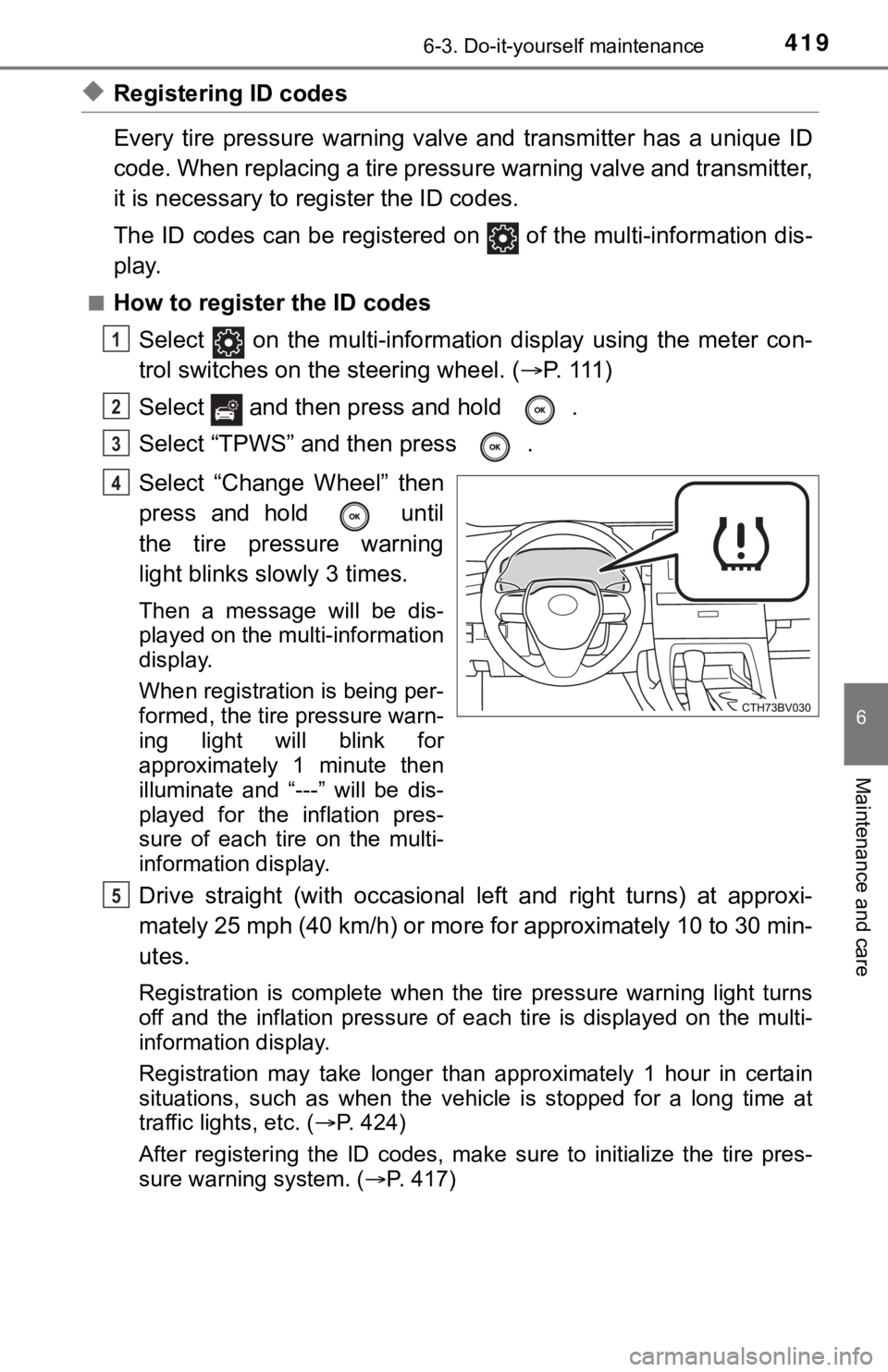2021 TOYOTA AVALON HYBRID warning
[x] Cancel search: warningPage 416 of 560

4166-3. Do-it-yourself maintenance
Your vehicle is equipped with a tire pressure warning system that uses
tire pressure warning valve and transmitters to detect low tire inflation
pressure before serious problems arise.
●The tire pressure detected by
the tire pressure warning sys-
tem can be displayed on the
multi-information display.
●If the tire pressure drops below
a predetermined level, the
driver is warned by a screen
display and a warning light.
(
P. 458)
Tire pressure warning system
Page 417 of 560

4176-3. Do-it-yourself maintenance
6
Maintenance and care
◆Installing tire pressure warning valves and transmitters
When replacing the tires or wheels, the tire pressure warning valve
and transmitters must be installed to the wheels which will be
installed to the vehicle.
When new tire pressure warning valve and transmitters are
installed, new ID codes must be registered in the tire pressure
warning computer and the tire pressure warning system must be
initialized. (P. 419)
◆Initializing the tire pressure warning system
■The tire pressure warning system must be initialized in the fol-
lowing circumstances:
●When the tire inflation pressure is changed such as when chang-
ing traveling speed or load weight.
●When the tire inflation pressure is changed such as when the tire
size is changed.
●When rotating the tires.
●After performing the transmitter ID code registration procedure.
(P. 419)
When the tire pressure warning system is initialized, the current tire
inflation pressure is set as the benchmark pressure.
■How to initialize the tire pressure warning system
Park the vehicle in a safe place and turn the power switch off.
The initialization procedure cannot be started while the vehicle is
moving.
Adjust the tire inflation pressure to the specified cold tire inflation
pressure level. (P. 508)
Make sure to adjust the tire pressure to the specified cold tire infla-
tion pressure level. The tire pressure warning system will operate
based on this pressure level.
Start the hybrid system. (P. 1 9 6 )
Select on the multi-information display using the meter con-
trol switches on the steering wheel. (P. 1 1 1 )
Select and then press and hold .
Select “TPWS” and then press .
1
2
3
4
5
6
Page 418 of 560

4186-3. Do-it-yourself maintenance
Select “Set Pressure” then
press and hold until
the tire pressure warning
light blinks 3 times.
Then a message will be dis-
played on the multi-information
display.
“---” will be displayed on the
multi-information display for
the inflation pressure of each
tire while initialization is being
performed.
Drive straight (with occasional left and right turns) at approxi-
mately 25 mph (40 km/h) or more for approximately 10 to 30 min-
utes.
Initialization is complete when the position of each tire is determined
and the inflation pressure of each tire is displayed on the multi-infor-
mation display.
Initialization may take longer than approximately 1 hour in certain
situations, such as when the vehicle is stopped for a long time at
traffic lights, etc. (P. 423)
7
8
Page 419 of 560

4196-3. Do-it-yourself maintenance
6
Maintenance and care
◆Registering ID codes
Every tire pressure warning valve and transmitter has a unique ID
code. When replacing a tire pressure warning valve and transmitter,
it is necessary to register the ID codes.
The ID codes can be registered on of the multi-information dis-
play.
■How to register the ID codes
Select on the multi-information display using the meter con-
trol switches on the steering wheel. (P. 1 1 1 )
Select and then press and hold .
Select “TPWS” and then press .
Select “Change Wheel” then
press and hold until
the tire pressure warning
light blinks slowly 3 times.
Then a message will be dis-
played on the multi-information
display.
When registration is being per-
formed, the tire pressure warn-
ing light will blink for
approximately 1 minute then
illuminate and “---” will be dis-
played for the inflation pres-
sure of each tire on the multi-
information display.
Drive straight (with occasional left and right turns) at approxi-
mately 25 mph (40 km/h) or more for approximately 10 to 30 min-
utes.
Registration is complete when the tire pressure warning light turns
off and the inflation pressure of each tire is displayed on the multi-
information display.
Registration may take longer than approximately 1 hour in certain
situations, such as when the vehicle is stopped for a long time at
traffic lights, etc. (P. 424)
After registering the ID codes, make sure to initialize the tire pres-
sure warning system. (P. 417)
1
2
3
4
5
Page 420 of 560

4206-3. Do-it-yourself maintenance
■When to replace your vehicle’s tires
Tires should be replaced if:
●The treadwear indicators are showing on a tire.
●You have tire damage such as cuts, splits, cracks deep enough to
expose the fabric, and bulges indicating internal damage
●A tire goes flat repeatedly or cannot be properly repaired due to the size
or location of a cut or other damage
If you are not sure, consult with your Toyota dealer.
■Replacing tires and wheels
If the ID codes of the tire pressure warning valve and transmitters are not
registered, the tire pressure warning system will not work properly. In this
case, after driving for about 20 minutes, the tire pressure warning light will
blink for approximately 1 minute and then illuminate to indicate a system
malfunction.
■Tire life
Any tire over 6 years old must be checked by a qualified technician even
if it has seldom or never been used or damage is not obvious.
■Routine tire inflation pressure checks
The tire pressure warning system does not replace routine tire inflation
pressure checks. Make sure to check tire inflation pressure as part of
your routine of daily vehicle checks.
■Low profile tires (vehicles with 18 or 19-inch wheels)
Generally, low profile tires will wear more rapidly and tire grip perfor-
mance will be reduced on snowy and/or icy roads when compared to
standard tires. Be sure to use snow tires on snowy and/or icy roads and
drive carefully at a speed appropriate for road and weather conditions.
■Maximum load of tire
Check that the maximum load of the replacement tire is greater than 1/2
of the Gross Axle Weight Ratings (GAWR) of either the front axle or the
rear axle, whichever is greater.
For the GAWR, see the Certification
Label. For the maximum load of the tire,
see the load limit at maximum cold tire
inflation pressure mentioned on the
sidewall of the tire. (P. 5 1 3 )
Page 422 of 560

4226-3. Do-it-yourself maintenance
■Situations in which the tire pressure warning system may not oper-
ate properly
●In the following situations, the tire pressure warning system may not
operate properly.
• If non-genuine Toyota wheels are used.
• If a tire has been replaced with a tire that is not an OE (Original
Equipment) tire.
• If a tire has been replaced with a tire that is not of the specified size.
• If tire chains, etc. are installed.
• If a window tint that affects radio wave signals is installed.
• If there is a lot of snow or ice on the vehicle, particularly around the
wheels or wheel housings.
• If the tire inflation pressure is much higher than the specified level.
• If wheels not equipped with tire pressure warning valve and transmit-
ter are used.
• If the ID codes of the tire pressure warning valve and transmitters are
not registered in the tire pressure warning computer.
●Performance may be affected in the following situations.
• When driving near a TV tower, electric power plant, gas station, radio
station, large display, airport or other facility that generates strong
radio waves or electrical noise
• When carrying a portable radio, cellular phone, cordless phone or
other wireless communication device
If tire position information is not correctly displayed due to the radio
wave conditions, the display may be corrected by changing the location
of the vehicle as the radio wave conditions may change.
●When the vehicle is stopped, the time taken for the warning to start or
turn off may be longer.
●When the inflation pressure of a tire drops rapidly, for example when a
tire has burst, the warning may not operate.
■Initialization procedure
●Make sure to perform the initialization procedure after adjusting the tire
inflation pressure.
Also, make sure the tires are cold before performing the initialization
procedure or adjusting the tire inflation pressure.
●If the power switch is turned off during initialization, it is not necessary to
restart the initialization procedure from the beginning as it will begin
automatically when the power switch is turned back to ON mode.
●If initialization has accidentally been started when it is not necessary,
adjust the tire inflation pressure to the specified level when the tires are
cold and then perform the initialization procedure again.
●While the position of each tire is being determined and the inflation pres-
sures are not being displayed on the multi-information display, if the
inflation pressure of a tire drops, the tire pressure warning light will come
on.
Page 423 of 560

4236-3. Do-it-yourself maintenance
6
Maintenance and care
■Warning performance of the tire pressure warning system
The warning of the tire pressure warning system will change in accor-
dance with the conditions under which it was initialized. For this reason,
the system may give a warning even if the tire pressure does not reach a
low enough level, or if the pressure is higher than the pressure that was
adjusted to when the system was initialized.
■If the tire pressure warning system is not initialized properly
●In the following situations, initialization may take longer than usual to be
completed or may not be possible. (Usually, the vehicle will need to be
driven for approximately 10 to 30 minutes to complete initialization.)
If initialization is not complete after driving approximately 30 minutes,
continue driving for a while.
• If the vehicle is driven on an unpaved road, it may take longer to com-
plete initialization.
• If the vehicle is backed up while performing initialization, data col-
lected during initialization will be cleared and it will take longer than
normal to complete.
• If the vehicle is driven in heavy traffic or another situation where other
vehicles are driven close by, it may take time for the system to recog-
nize the tire pressure warning valve and transmitters of your vehicle
over those of other vehicles.
If initialization is not complete after driving for approximately 1 hour,
park the vehicle in a safe place for approximately 20 minutes and then
drive the vehicle again.
●In the following situations, initialization will not be started or was not
completed properly and the system will not operate properly. Perform
the initialization procedure again.
• If, when attempting to start initialization, the tire pressure warning light
does not blink 3 times.
• If, when the vehicle has been driven for about 20 minutes after per-
forming initialization, the tire pressure warning light blinks for approxi-
mately 1 minute and then illuminates.
●If initialization cannot be completed after performing the above proce-
dure, contact your Toyota dealer.
■When registering ID codes
●Before performing ID code registration, make sure that no wheels with
tire pressure warning valve and transmitters installed are near the vehi-
cle.
●Make sure to initialize the tire pressure warning system after registering
the ID codes. If the system is initialized before registering the ID codes,
the initialized values will be invalid.
●As the tires will be warm when registration is completed, make sure to
allow the tires to cool before performing initialization.
Page 424 of 560

4246-3. Do-it-yourself maintenance
■Canceling ID code registration
●To cancel ID code registration after it has been started, turn the power
switch off before driving the vehicle.
If the vehicle is driven after ID code registration is started, to cancel reg-
istration, perform the ID code registration start procedure again and turn
the power switch off before driving.
●If ID code registration has been canceled, the tire pressure warning light
will blink for approximately 1 minute when the power switch is turned to
ON mode and then illuminate. The tire pressure warning system will be
operational when the tire pressure warning light turns off.
●If the warning light does not turn off even after several minutes have
elapsed, ID code registration may not have been cancelled correctly. To
cancel registration, perform the ID code registration start procedure
again and then turn the power switch off before driving.
■If ID codes are not registered properly
●In the following situations, ID code registration may take longer than
usual to be completed or may not be possible. (Usually, the vehicle will
need to be driven for approximately 10 to 30 minutes to complete ID
code registration.)
If ID code registration is not complete after driving for approximately 30
minutes, continue driving for a while.
• If the vehicle is driven on an unpaved road, it may take longer than
normal to complete registration.
• If the vehicle is backed up while performing registration, data col-
lected during registration will be cleared, and it will take longer than
normal to complete.
• If the vehicle is driven in heavy traffic or another situation where other
vehicles are driven close by, it may take time for the system to recog-
nize the tire pressure warning valve and transmitters of your vehicle
over those of other vehicles.
• If a wheel with a tire pressure warning valve and transmitter installed
is inside or near the vehicle, registration of the ID codes for the
installed wheels may not be possible.
If ID registration is not complete after driving for approximately 1 hour,
park the vehicle in a safe place for approximately 20 minutes and then
perform the ID code registration procedure again.
●In the following situations, ID code registration will not be started or was
not completed properly and the system will not operate properly. Per-
form the ID code registration procedure again.
• If, when attempting to start ID code registration, the tire pressure
warning light does not blink slowly 3 times.
• If, when the vehicle has been driven for about 20 minutes after per-
forming ID code registration, the tire pressure warning light blinks for
approximately 1 minute and then illuminates.
●If ID code registration cannot be completed after performing the above
procedure, contact your Toyota dealer.